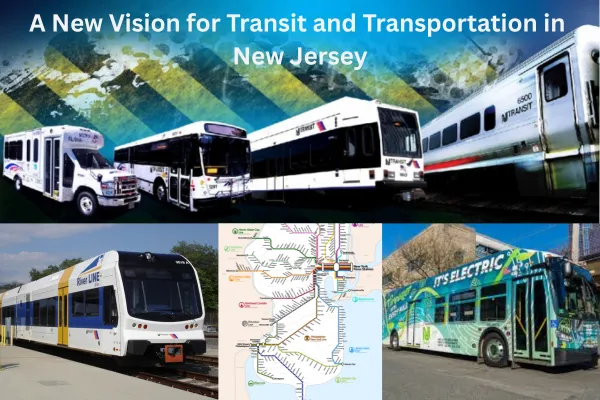
A New Vision for Transit and Transportation in New Jersey
A New Vision for Transit and Transportation in New Jersey
By Stephen Zielinski Sr, Candidate for Governor of New Jersey
New Jersey’s public transit system—once a model of connectivity—is now in a state of crisis. The collapse of private bus companies has forced NJ Transit to absorb additional responsibilities even as its core services remain underfunded and overstretched. From North Jersey’s clogged commuter corridors to South Jersey’s disconnected towns, millions of New Jerseyans are left with inadequate options for getting to work, school, healthcare, or family.
Meanwhile, the New Jersey Department of Transportation proposes to sink billions into highway expansions—such as the $10.7 billion NJ Turnpike widening through Jersey City—projects that do little to solve traffic problems, exacerbate pollution, and defy our climate obligations. This is not just bad planning; it’s an ethical failure.
We must reimagine New Jersey Transit—not just as a service, but as a pillar of economic justice, climate resilience, and social equity. As Governor, I will bring forward a transformative vision to not only fund NJ Transit sustainably, but to expand it, electrify it, and center it in our long-term development strategy.
A Four-Pillar Plan for Sustainable Transit Investment
1. A Public Bank of New Jersey
We will establish a state-run public bank, designed to serve the people of New Jersey—not Wall Street. This bank will provide low-interest financing for major transit capital projects and reinvest its profits directly into NJ Transit’s operating budget.
With a public bank, we can:
Fund the electrification of our bus and light rail fleets.
Finance transit-oriented developments (TODs) that grow our tax base and ridership.
Remove the volatility of relying on annual budget fights or federal political shifts.
2. Redirect Misallocated Funds
We will cancel the Turnpike expansion and redirect those funds—nearly $11 billion—toward:
Expanding light rail in both North and South Jersey.
Purchasing electric buses and building high-speed charging stations.
Replacing broken and aged infrastructure to improve reliability and service frequency.
Spending billions to widen highways while underfunding mass transit in one of the most densely populated states in the country is short-sighted and unacceptable.
Reforming NJ Transit Leadership
Real reform won’t happen without changing the leadership and vision of NJ Transit. We must bring in new management that thinks outside the box, is focused on the public good, and is free from the grip of corporate interests that have slowed innovation and blocked meaningful progress.
This new leadership will be tasked with:
Prioritizing rider needs and frontline workers over political favors.
Partnering with labor unions to ensure fair wages, safe working conditions, and long-term employment growth.
Embracing green technology, regional connectivity, and inclusive service planning.
From Highways to High-Frequency Transit: Shifting Priorities
We must reject the false choice between mobility and sustainability. New Jersey can have both—but only if we prioritize investments that serve people, not just cars.
✅ Light Rail Expansion
We will focus on a hub-and-spoke model, where rail and bus rapid transit (BRT) lines connect residential and job centers across the state.
A signature project of this vision is a light rail line from Bay Head Junction to Atlantic City, a corridor that could serve 14 to 16 municipalities. This rail line would:
Connect underserved regions in Ocean and Atlantic Counties.
Support economic recovery and growth in post-industrial towns.
Cost between $4 billion and $7.5 billion, fundable through the public bank, TTF, and federal partnerships.
This project would boost property values, reduce reliance on cars, and create thousands of union jobs—in construction, operations, and surrounding development.
✅ South Jersey Investment
Too often overlooked in statewide transit plans, South Jersey deserves:
Expanded rail connections between Atlantic City, Camden, and Philadelphia.
Electrified BRT corridors with reliable, frequent service.
Light rail extensions that reflect the needs of the region’s workers, students, and seniors.
✅ Integrated Green Energy Infrastructure
We will lead the country by:
Installing solar-powered charging hubs at bus depots and Park-and-Rides.
Equipping NJ Transit facilities with solar canopies, battery storage, and EV chargers.
100% fleet electrification by 2035, including buses, paratransit vehicles, and support services.
This is a climate strategy and a cost-saving one: less fuel, less maintenance, cleaner air—and more green energy jobs.
Why This Vision Matters
Transportation is not just about roads and tracks. It’s about equity, access, health, and opportunity. It's about how we reduce emissions while rebuilding communities left behind. It's about connecting rural areas to job centers, supporting immigrant families with mobility, and ensuring every resident—regardless of zip code—can move freely, safely, and affordably.
It’s also about respecting the dignity of labor. This plan is a blueprint for job creation, union growth, and worker empowerment, ensuring that as we build the transit system of tomorrow, we also support the working people who make it run.
New Jersey’s future must not be tethered to the failed strategies of the past. As Governor, I will prioritize people over pavement, transit over traffic, and climate leadership over political convenience.
We will fund NJ Transit like the essential public service it is. We will build a rail and bus network worthy of our working families. And we will lead the nation in green, just, and inclusive transportation policy.
Let’s move New Jersey forward—together, on track.

